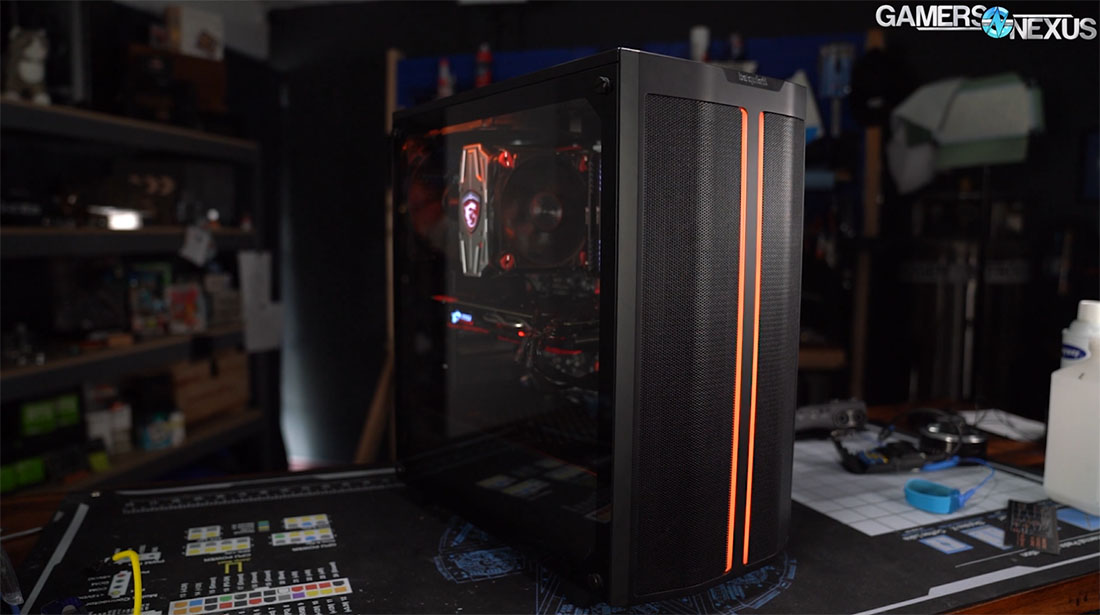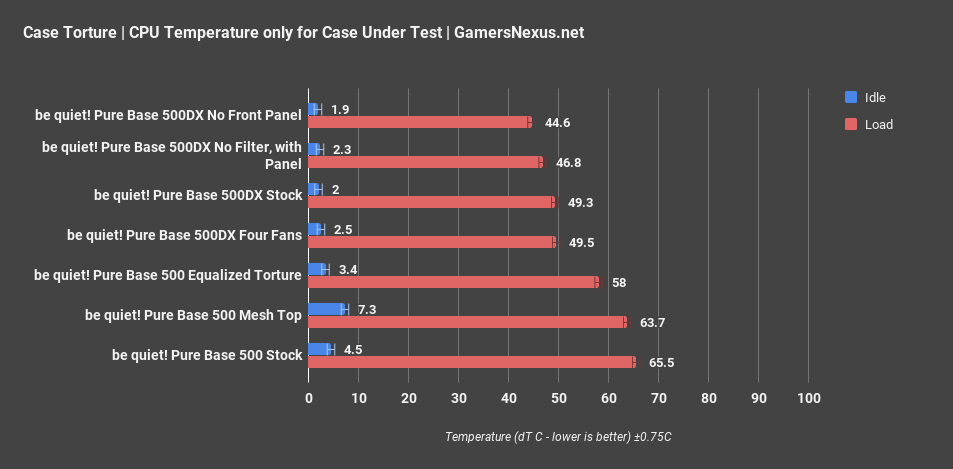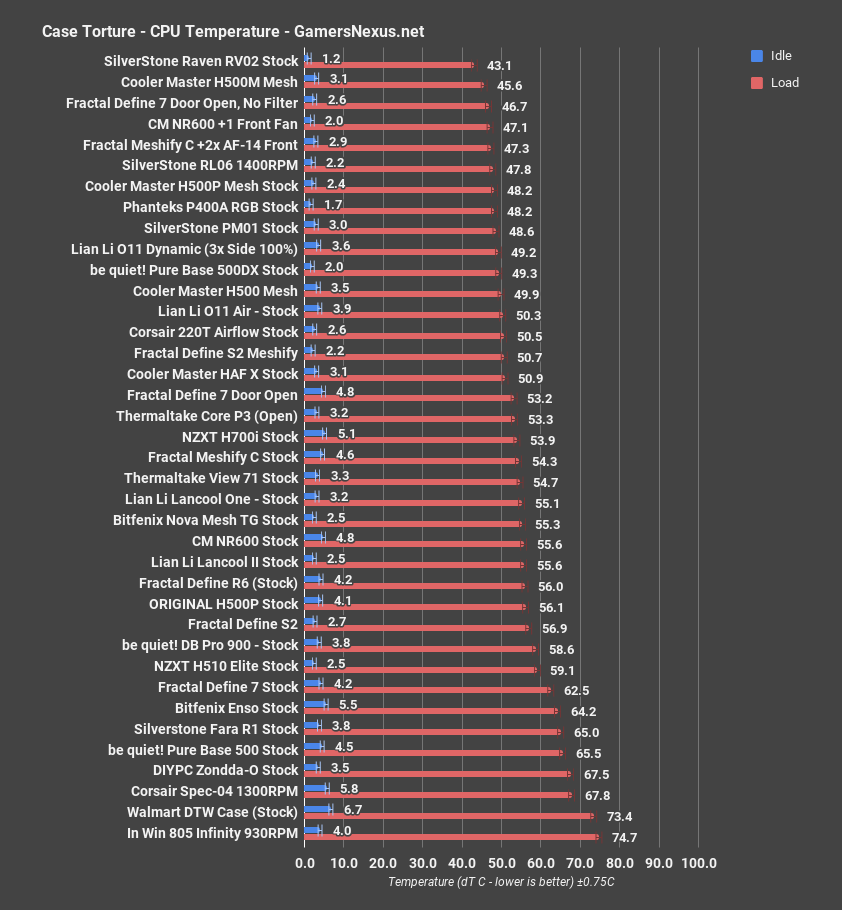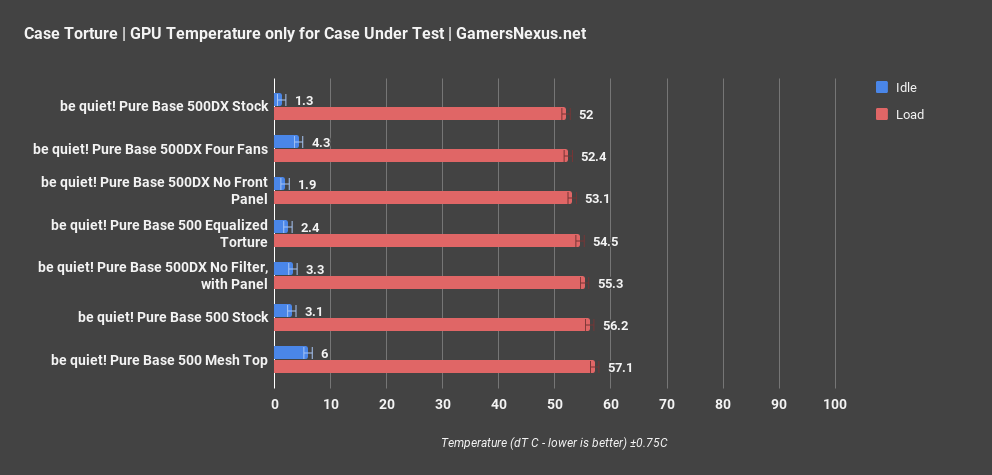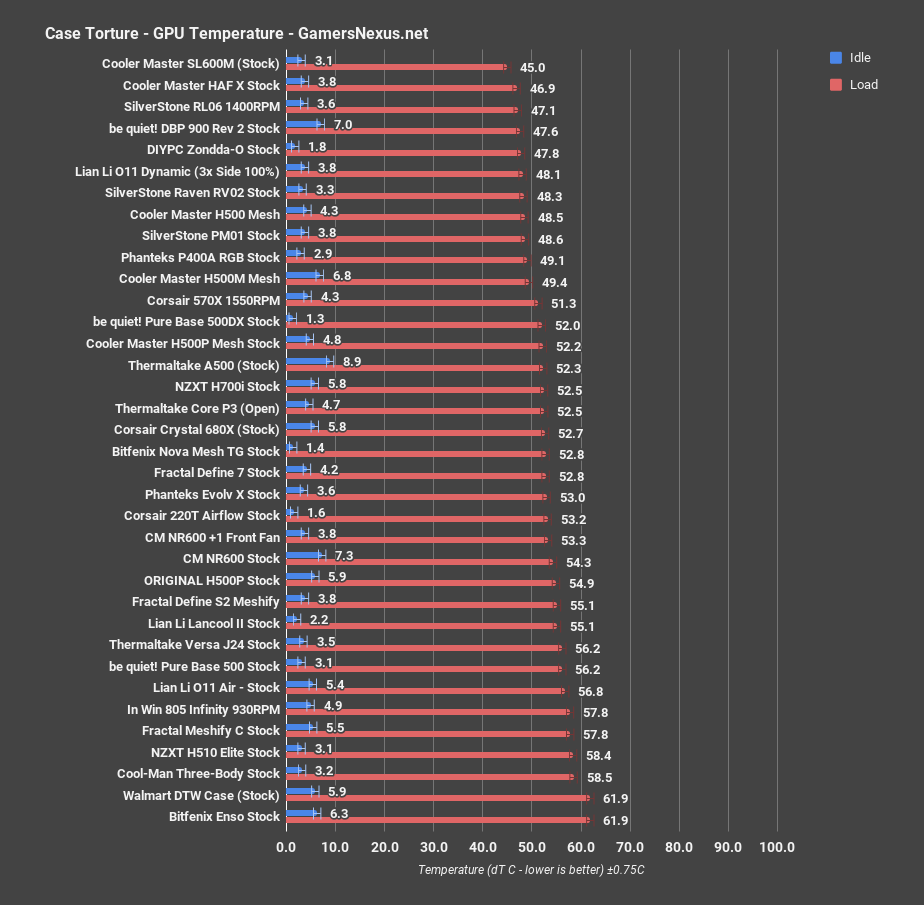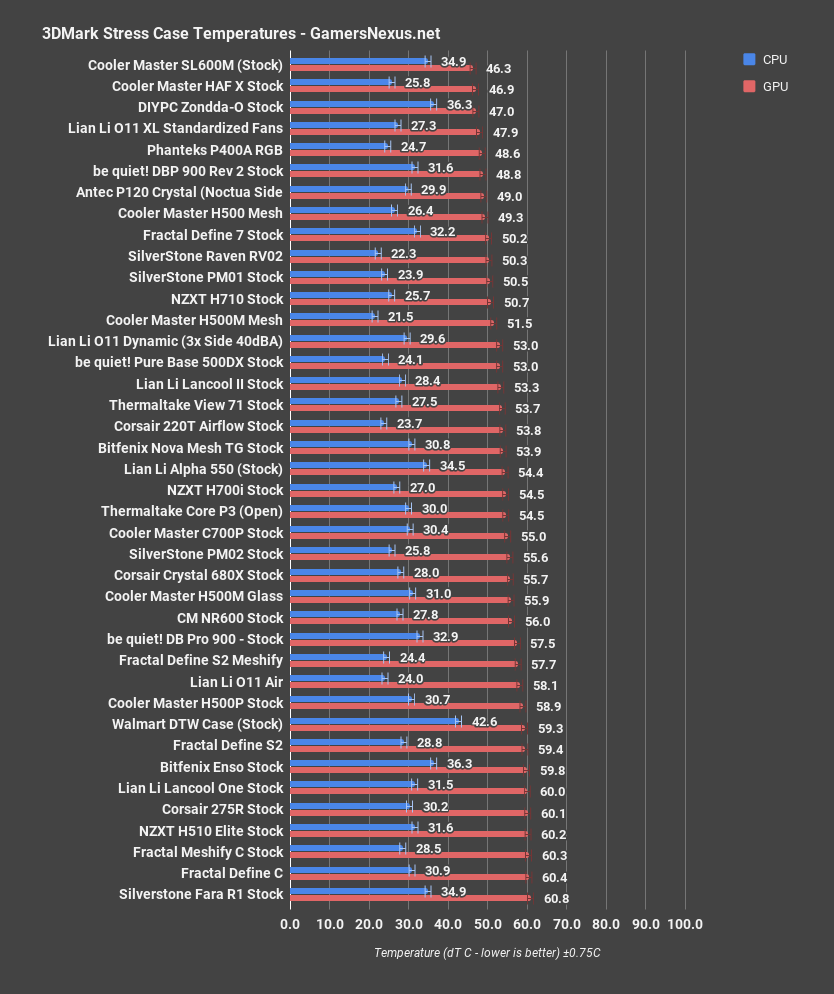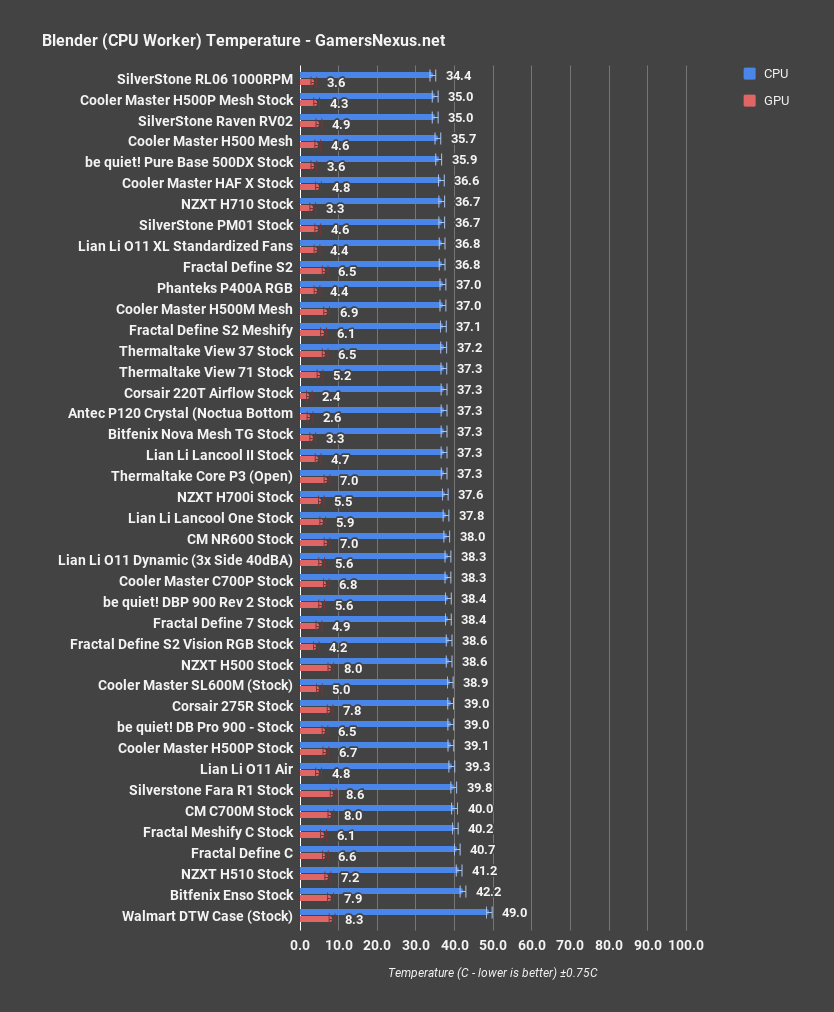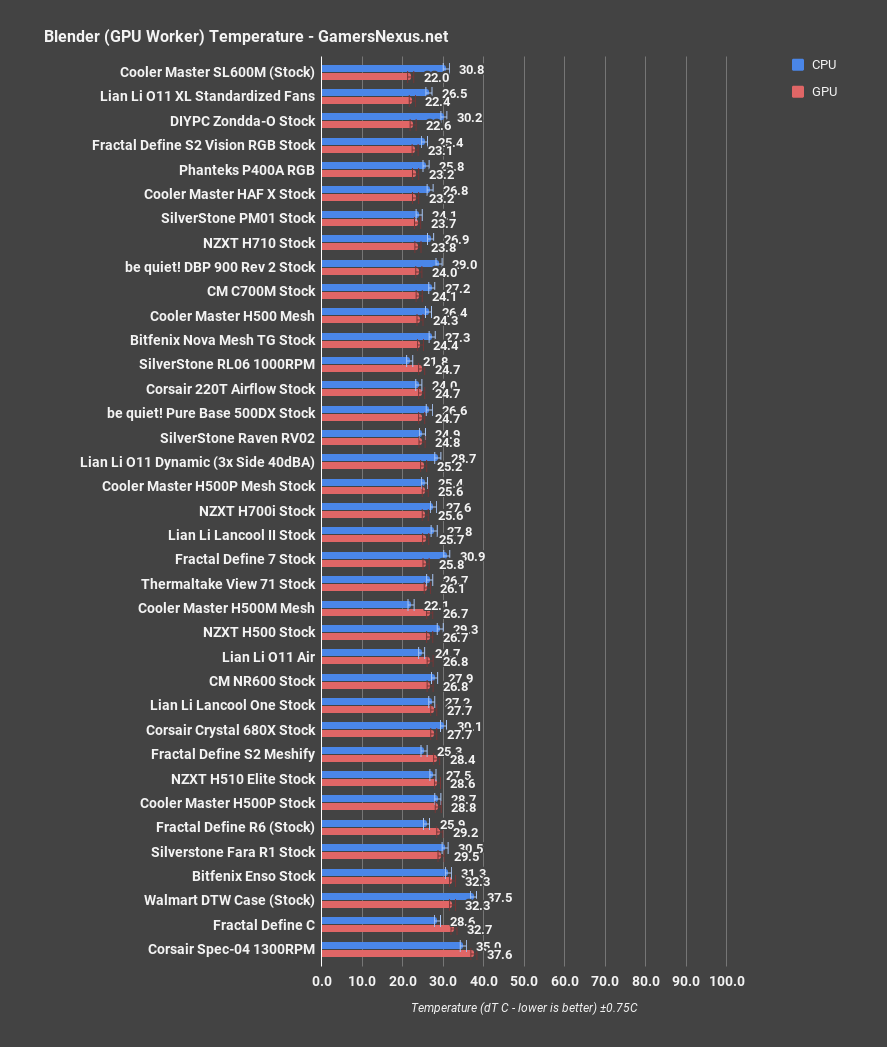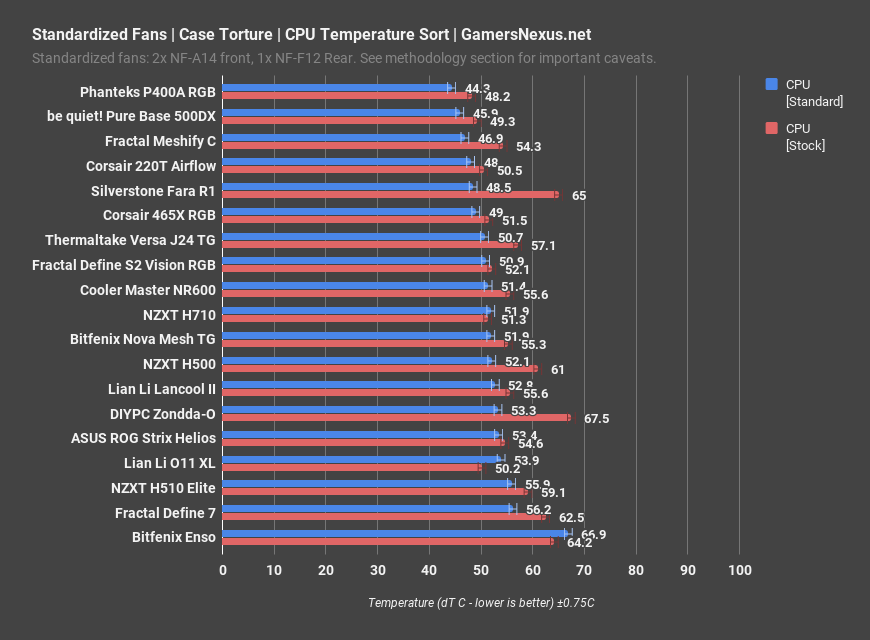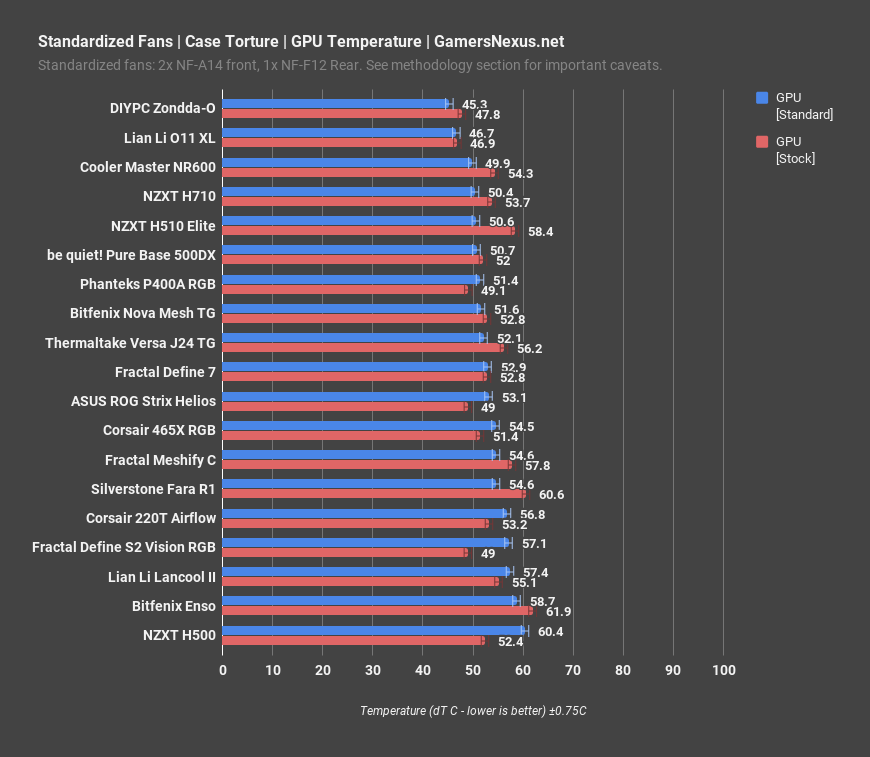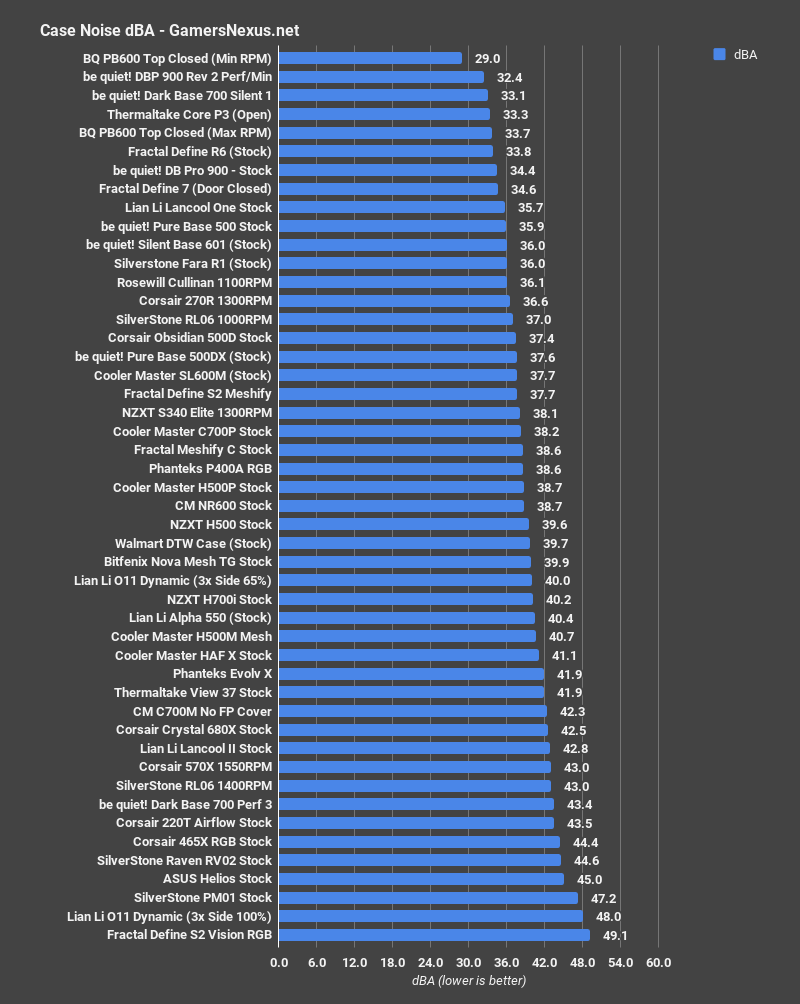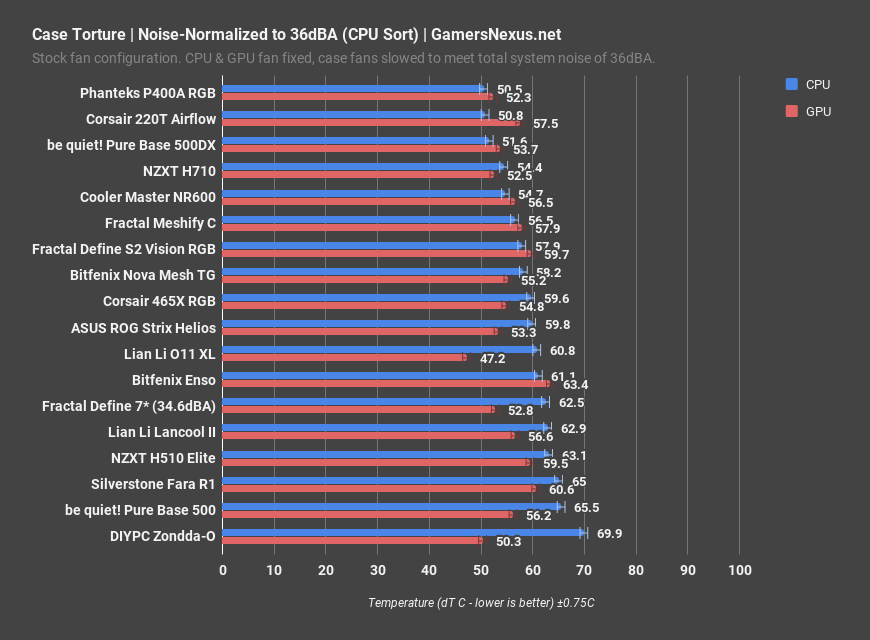The original be quiet! Pure Base 500 completely failed to pique our interests. It was another mid-tower we knew would have subpar airflow in the $80-$90 range (depending on the configuration), not cheap enough to excuse faults or expensive enough to make it offensively bad. We’re much more interested in the new variant, the 500DX. We were informed back at CES that the DX stands for Deluxe, which may or may not have been made up by be quiet! on the spot, but the gist is a slightly higher-end airflow focused model that’s still part of the Pure Base line, traditionally the least expensive of their three case families. The DX is priced at $99.90, a little more than the original, but comes with an additional fan, RGB lighting, and a mesh front panel. Today we’ll be reviewing the 500DX and pulling our Pure Base 500 from storage to do some tests and comparisons with the original.
The press release for the 500DX informed us that it has a “playful yet elegant” design. In spite of that deeply unpleasant description plagiarized from an Aston Martin ad, the 500DX does look pretty good, especially the black version. The plastic frame behind the mesh that was clearly visible in the white prototype we saw at CES is much less visible on the black model, where the fans, front panel, and chassis all blend together in the shadows. ARGB lighting is smooth and defaults to a solid be quiet! orange, so some credit is due for customizing the lighting profile on the integrated RGB controller. Baked-in profiles can be cycled through with a button on the front panel, or lighting can be controlled via a 3-pin 5V header. The front panel LEDs are connected with spring-loaded pins, so the panel can be removed without unplugging any cables. There’s an additional strip of LEDs along the top edge of the case, but these are less visible than the ones on the front in a well-lit room, and the default orange lighting looks much stranger on the interior of the case than the exterior. Customers planning to augment the fans on the black model may want to stick to more black fans--the stock Pure Wings fans blend in perfectly, while the beige Noctua fans we used for one of our thermal tests were partially visible.
Motherboard compatibility | ATX, M-ATX, Mini-ITX |
Case type | Midi-Tower |
PSU | PS2 ATX (not included) |
Dimensions (L x W x H in mm) | 510 x 285 x 501 |
Material | Steel (SGCC), ABS plastic, tempered glass |
Weight (kg) | 7.83 (net) / 8.92 (gross) |
I/O panel | 1x USB Type C Gen. 2, 1x USB 3.0, HD Audio, LED Switch Button |
PCI slots | 7 |
Drive bays | Up to 5x 2.5 (5 included) Up to 2x 3.5 (2 included) |
Preinstalled fans (mm) / (rpm) | Front: 1x Pure Wings 2 140 / 900 Top: 1x Pure Wings 2 140 / 900 Rear: 1x Pure Wings 2 140 / 900 |
Optional fans (mm) | Front: 1x 140 / 3x 120 Top: 1x 140 / 120 |
Optional radiators (mm) | Front: 120, 140, 240, 280, 360 Top: 120, 240 Rear: 120, 140 |
Maximum dimensions (mm) | CPU cooler: 190 PSU: 258 / 225 (depending on position of the HDD cage) GPU: 369 |
Special features | Switchable multi mode and multi color ARGB LED lighting(white, red, green, blue, orange, purple), internal and external, supports motherboard LED control |
MSRP | $99.90 |
The top filter is a good example of a minor touch that makes the case feel significantly more expensive: the filter is contained in a plastic frame with a bevelled edge that fits precisely into a depression on the top of the case, although slapping a bare rectangle of mesh onto the chassis would have functioned equally well. The original 500 includes an identical filter as an optional accessory, but comes with a flat plastic cover installed instead, so this is one area where the original case comes with more options than the DX--but frankly, we’re happy to leave the cover behind. The cover is designed purely for noise suppression rather than filtration (check the noise testing section for more detail), so in our book it’s a straight downgrade from just leaving the top of the case bare, especially since most cases end up being quieter on lower RPM fans that don’t have to fight as much impedance. Eliminating the more complex plastic cover is probably part of the reason the 500DX isn’t that much more expensive than the base model: the mesh cover appears to be simpler to manufacture, and therefore probably less prone to QA issues. The noise-suppression cover requires exact placement of eight separate specially-shaped magnetic strips and a pad of noise-damping foam, as well as manual finishing of the frame’s corners to make it fit flush with the case. One of the magnets on our non-DX sample slightly overlapped the foam pad, doubling the height of the filter at that corner and making it stick up noticeably. The mesh cover, on the other hand, uses four magnetic strips without any strict requirements for size or placement, four rare-earth magnets at the corners, and a simpler edge shape. Users should generally forego the top filter entirely when using top exhaust, but be quiet!’s stock configuration is set up for negative pressure, so the filter may still be helpful.
The front panel is the main attraction of the DX upgrade. As we alluded to earlier, the ventilation gaps are smaller than the size of the mesh sections on the front of the case would suggest, since the reinforcing plastic frame blocks a large portion of them. The frame can’t be any narrower towards the edges without significant retooling, since this is where the clips are located for attaching to the chassis, but the almost 6cm-wide strip in the middle that holds the LEDs is purely a sacrifice to aesthetics. What remains for airflow are two open strips approximately 5.5cm wide each on either side. Great pains were taken to ensure a flush panel, especially around the front I/O, where there are several extra plastic hooks. The 500’s front panel also has small plastic spacers along each side to hold it away from the edge of the chassis; the 500DX doesn’t need them because the plastic is less delicate in that location. Both front panels are fairly stiff but can be yanked off without fear of damaging the case. The original 500 used mesh strips along the sides of the front panel combined with three tiny removable filters along the sides and bottom, while the 500DX is much more straightforward, combining the mesh front panel with a single standard magnetic filter. We like this filter--it hooks into the chassis on one side and is magnetic on the other, so it shuts like a door. Ideally the filter would be accessible without disassembling the case at all, as with the Dark Base Pro 900, but that’s a rare feature. The bottom filter is wide, covers the full length of the case, and ejects from the front--all positive points.
The side panel attachment is the same as on many other be quiet! cases, including their top-of-the-line Dark Base Pro 900 rev. 2, and although it makes sense for the Pure Base line, we hope they come up with something more advanced in the future for their high-end cases. It’s the usual fragile metal tabs punched out of the steel of the side panel that slot into holes in the case on one side, and thumbscrews through glass on the other. Both work fine, and be quiet! does a good job of shaping its steel side panels with rails that keep them rigid and slide neatly into place, but there are better ways to do this, like the NZXT H710’s system. All thumbscrews on the case (other than the ones through the glass panel) are captive.
The 500 and 500DX both include several small quality of life features that we’ve made a point of praising in the past, like a movable/removable HDD cage and a frame for the PSU that allows it to be inserted from the rear of the case. Leaving the HDD cage in its default forward position left about 9.5cm between it and the body of our 16cm-long ATX PSU, adequate room for storing cables without removing the cage, which is increasingly a problem as mid towers become more compact. Since the DX adds an additional fan at the rear of the case, there’s extra potential for cables clipping fan blades, and be quiet! has added a small adhesive clip in the back corner of the case to keep fan cables safely tucked away. The one feature we associate with cases of this tier that’s missing is a removable radiator tray.
What other manufacturers might call a cable management bar has been dubbed an “SSD panel” by be quiet!. This panel is designed to hold two SSDs so that they’re visible from the interior of the case, but with their cables hidden behind a removable plastic insert bearing the be quiet! logo. As cable management bars go, this isn’t our favorite, but bear in mind that it is completely removable by loosening a single captive thumbscrew and that there are plenty of other SSD mounting locations. The main problem is that the cable gap along the edge of the panel routes cables at a right angle. That’s great for boards that have their 24-pin power connectors pointing out from the edge of the board, like EVGA’s Dark series, but it makes it more difficult to route cables into other things, like normally-oriented 24-pin connectors or PCIe power cables. There are also no cable tie points anywhere on the SSD panel, which is something of a missed opportunity, although there are plenty elsewhere. Accounting for the space taken up by noise-damping foam, there’s about 2cm of clearance between the motherboard tray and the side panel for routing cables.
Front I/O is one USB C port and one USB 3.0 port, a mic jack, and a headphone jack. The original 500 included two USB 3.0 ports, one of which has been retrofitted into the DX’s type C port. Only having a single USB type A connector available on the front panel is rough. Retooling just to add a port to the front panel would be expensive, but this alternative feels more like a sidegrade than a “deluxe” feature.
THERMALS & NOISE
This is a review of the 500DX, not the Pure Base 500. We therefore performed many tests using the 500DX, more than usual even, but only a couple comparative tests on the Pure Base 500. For the DX, we ran the standard suite plus one test without the superfluous front and top filters, and one test with an additional 140mm Pure Wings 2 fan (for a total of four) installed as a front intake. For the 500, we did one stock test, one test using the included mesh top rather than the plastic cover, and one test with three fans configured to match the 500DX (the 500 only comes with two).
CPU Torture
We’ll start with only the 500-series be quiet! cases, then move on to the comparative charts. The baseline CPU temperature during the first torture test was 49 degrees Celsius over ambient, which only dropped to 45 degrees dT with the removal of the front panel (while leaving the front and top filters in place). The two exhaust fans in the rear of the case are the ones primarily responsible for CPU cooling, and their efficacy isn’t directly dependent on the front panel. Removing just the optional filters from the front and top of the case lowered CPU dT to 47 degrees, not quite as good as removing a whole panel, but much more practical for daily use. Adding another front intake fan to the case had no significant impact on CPU thermals versus baseline for this specific build configuration. The original 500 had a baseline CPU temperature of 66 degrees, massively increased over the DX and hot enough to cause some brief and minor throttling as the logged CPU temperature brushed up against the 100-degree mark. Testing with the mesh top filter instead had a slightly better result with a 64C dT average. Emulating the DX’s three-fan configuration helped slightly more and pushed the average down to 58 degrees over ambient. That’s still much, much worse than baseline for the DX--the front panel really does make the difference. We wouldn’t recommend the non-DX.
Comparatively, 49 degrees is the lowest stock CPU dT of any be quiet! case we’ve tested. We have a back catalog of them you can see in previous reviews. To be fair to their other cases, the company’s name is be quiet!--they have a specific focus, and it’s not thermal performance--but we maintain that lower noise levels can be attained with more carefully thought-out cooling by reducing fan RPMs. Comparing the 500DX to other mesh-fronted cases like the RL06 at 48 degrees over ambient and the Fractal Meshify S2 at 51C dT reveals that it does hold its own compared to the rest of the chart. The Fractal Meshify C and Cooler Master H500 (Mesh) are closer to being direct competitors, and we’ve mentioned several times that the Meshify C’s stock thermals are a weak point, with an average CPU dT of 54C thanks to less-than-ideal stock fans. Even the H500 Mesh averaged a degree higher, at 50C dT, which is within error. The Pure Wings 2 fans that are included with this case aren’t the best or the fastest be quiet! has to offer, but they’re 140mm, there are three of them, and they’re configured in a somewhat unusual way that NZXT has proven in its H500 series can still work. There are two exhaust fans dedicated to CPU cooling, so the relatively neglected GPU will be the tougher test.
GPU TORTURE
GPU torture for just the be quiet! 500 cases is up next. GPU temperature in the stock configuration was 52 degrees over ambient, and it resisted attempts to improve from that baseline. Removing the front panel resulted in an average within error of stock, at 53 degrees, and removing the filters an even worse average of 55C dT. We’ve seen this kind of thing before, especially in the similarly-configured NZXT H500: negative pressure setups create unpredictable airflow patterns, and altering those patterns can have unforeseen effects. If the negative pressure setup encourages cool air to flow in through the PCIe covers at the rear of the case, or even the top of the PSU shroud, allowing the front intake fan to push more air into the case may result in worse airflow to the GPU overall. Adding the second front intake fan also had no significant effect on GPU thermals. The 500DX isn’t the massive upgrade over the 500 for GPU thermals that it was for CPU thermals, but the 500’s baseline GPU dT of 56C is still definitely worse. Using the mesh top rather than the solid cover allowed the top section of the case to interact less with hot exhaust from the GPU, and average temperature climbed slightly to 57 degrees. Matching the DX’s fan configuration still only brought the average down to 55C dT. The mesh front panel is better.
Comparatively, 52 degrees for the GPU is closer to average on our chart than the CPU thermals were, but it’s still in good company for stock thermals. Performance isn’t quite as good as the Cooler Master H500 blank Mesh’s 49-degree average, but several degrees better than the stock Meshify C’s average of 58C dT. A build with radiators merits fans with higher static pressure, but for air-cooled systems, be quiet! has at least included enough fans to start with--and for once, they’ve shipped a case that’s practical for an air-cooled system.
3DMARK
The Firestrike Extreme test resulted in an only slightly higher GPU temperature than the torture test, averaging 53 degrees over ambient. That’s still beaten by the H500 Mesh at 49.3 degrees, and still better than the Meshify C at 60 degrees. GPU thermals with our configuration are fair, but given how touchy the negative pressure configuration is, that will vary with the system layout. The stock configuration works well enough for a system like ours, but buyers of this case should definitely play around with the fan placement to find the ideal layout for their own system.
BLENDER
With CPU temperatures already good in the stock torture test even with the added heat from a GPU workload, the DX should do even better in the pure CPU Blender rendering workload. Average CPU temperature was 36 degrees, which ties it with the H500 Mesh and easily beats the Meshify C’s 40C dT average. The H500P Mesh and Silverstone RV02 are the only stock results that beat it, and only by a couple degrees, and a test with the RL06’s stock fans reduced to 1000RPM makes the cut as well. It should be clear by now, but the 500DX has good CPU thermals.
The GPU accelerated render resulted in a GPU dT of 25C. That’s not quite up to the level of the P400A at 23C dT or the H500 Mesh at 24C, but it’s close. Forcing a more traditional front-to-back airflow pattern with positive pressure wouldn’t help the GPU temperature, but it would help control where air enters the case and direct it through filters. We prefer to err on the side of better airflow and commit to cleaning dust out of the case more frequently, but three stock fans is enough that users can choose for themselves among many different configurations.
STANDARDIZED FANS
Doing a test with the 500’s fans matched to the 500DX’s accomplished part of the purpose of our standardized fan test, but installing our usual three Noctua fans allows us to see how the DX’s cooling potential matches up to some of our other cases. 46 degrees CPU dT is very strong relative to the rest of the cases on the chart, beaten only by the P400A RGB. We do the standardized fan test with the two 140mm fans installed in front intake slots and the one 120mm as rear exhaust if possible, and apparently that works as well as the stock negative-pressure setup for CPU thermals. At least it does when you use much higher RPM fans than the 900-1000ish RPM ones be quiet! ships.
GPU dT averaged 51C dT, not much better than the stock test, for the same reasons that we discussed in the GPU torture section above. It’s a respectable temperature, but much nearer the middle of the pack than the CPU result was. With a standard front-to-back airflow pattern using these fans, the 500DX matches the P400A RGB and the H510 Elite for GPU cooling.
NOISE & NOISE NORMALIZED
Noise is obviously an important concern for all of be quiet!’s cases, perhaps a little less so than usual for the airflow-focused DX. We measured the noise level of the original 500 to be 35.9 dBA and the noise level of the 500DX to be 37.6dBA. Noise levels are measured 20 inches from the front panel with case fans at 100% speed and GPU/CPU fans controlled, as usual, so we didn’t detect any significant difference in noise levels between the mesh top and the plastic cover since the top panel was above and pointed away from the decibel meter. When using the stock fans, we’d recommend using the mesh top filter or nothing at all: the 500’s plastic cover offers no advantages.
Stock noise levels for the original 500 are already at our 36dBA threshold, meaning that the original torture results can be compared to this chart, while the 500DX required lowering all case fans to 85% speed (logged as approximately 850RPM) to meet the threshold. That’s a fairly small reduction compared to the usual amount required to get mesh-fronted cases down to 36dBA.
Accordingly, the 500DX performed well here with a CPU dT not much higher than the torture result, averaging 52C dT. It’s cooler than all cases other than the Corsair 220T Airflow and Phanteks P400A RGB, which are tied at 51C dT.
For GPU dT, the DX averaged 54C. As usual, that’s nearer to average compared to other GPU temperatures on the chart, but still acceptable. The P400A RGB still does better by a couple degrees, as does the NZXT H710, but the only cases that beat it by a large margin are ones with direct GPU cooling like the DIYPC Zondda-O and our custom configuration of the Lian Li O11 XL.
CONCLUSION
The Pure Base 500 was a well received case. We don’t particularly like it because the thermal performance is bad. The Pure Base 500DX is a Pure Base 500 with good thermal performance: everyone wins. The $100 price point may be a little less tempting than the $70-$85 range the original 500’s SKUs are currently listed at, but it is in fact a better case than the original 500. The 500DX is competitive with other mesh-fronted cases near its price class like the H500 Mesh, Fractal Meshify C, and P400A RGB, especially for customers that intend to make use of the three included stock fans rather than substituting their own. This is the first be quiet! case we’ve reviewed that has had any RGB effects beyond some basic strips around the panel edges, but they haven’t gone overboard--the ARGB lighting effects are well done without being obnoxious. It’s also a legitimately quiet case, regardless of whether that’s down to the noise-damping efforts or simply the low RPM of the stock fans.
Editorial, Testing: Patrick Lathan
Host, Test Lead: Steve Burke
Video: Keegan Gallick, Andrew Coleman
